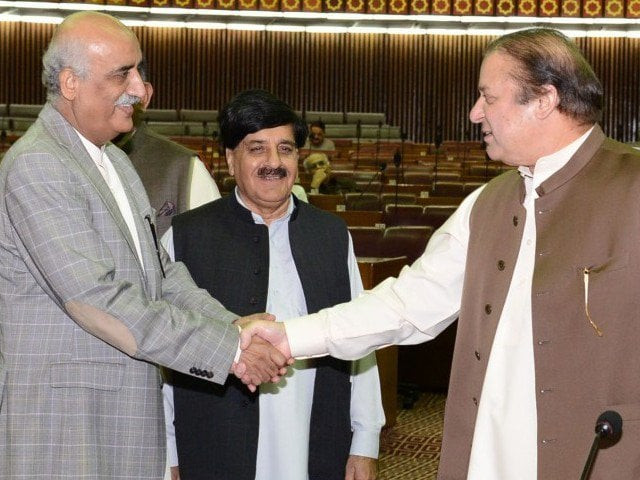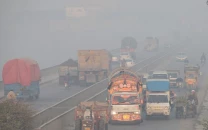NA performance: Dharnas brought PM back into parliament, but activity remains stagnant
According to Pildat's report Parliament's performance largely remained stagnant

During the second parliamentary year of 14th National Assembly, the premier attended 33 sittings as compared to only seven sittings he attended during the first parliamentary year of incumbent assembly. PHOTO: PID
The evaluation report, which is based on an international framework developed by the Inter-Parliamentary Union, shows that apart from the appearance of Prime Minister Nawaz Sharif in the National Assembly this year, the assembly’s overall performance declined to 48% from the average score of 49% of 13th National Assembly during the Pakistan Peoples Party led regime.
During the second parliamentary year of 14th National Assembly, the premier attended the parliament 33 times, compared to only seven during the first parliamentary year.
While the the prime minister attended 36 per cent of the total sessions of the Parliament, the Leader of the Opposition Syed Khursheed Shah attended 71 sessions, which translates into 78% attendance.

The number of sessions that the Parliament met during the second year also declined by almost 12 per cent as it met 91 times, compared to 103 sessions in the first year. While the average duration of Parliamentary sessions remained no more than three hours. The life of National Assembly is divided into sessions and it must meet for at least 130 days and there must be at least three sessions in a year.
The lesser frequency of parliamentary sessions also reflected in the number of resolutions passed during the year, as only 26 resolutions were passed in 2014-15, which was 54% per cent lesser than last year’s figure of 56.
While the National Assembly has refused to share the attendance figure of MNAs with the public, the average maximum attendance was no more than 43 per cent of total attendance, which translates into 145.68 MNAs/session, showing the lack of will of members to attend the parliamentary sessions on a regular basis.
Despite the precedent set by the Provincial Assembly of the Punjab by making attendance of its members available online, the National Assembly continued to flout the standards of openness and transparency in this regard.
In addition to the dwindling number of resolutions, the number of bills saw a mixed response. Government Bills introduced doubled from 13 in the first year to 26 in the second parliamentary year. But fewer sessions meant that there were fewer debates and consensus reached on bills to be passed, which declined by 27%. Of the 26 bills introduced by the government, only eight were passed (30.6 pass percentage) as compared to 11 (84.6% pass percentage) in the first year.
The National Assembly's legislative capacity also registered a decline in evaluation scores by one percentage point. The assembly’s legislative capacity has also suffered a significant drop of 75% from the five-year average of passing bills in the 13th National Assembly.
The introduction of private member bills also saw significant decline of almost 42% in 2014-15. Only 25 private members bills were introduced as compared to 43 last year, mostly due to the lack of passage of private bills. It is pertinent to mention here that on average three Private Members’ Bills were passed in the previous assembly.
The National Assembly again failed to introduce any reform to make its members’ role more meaningful in scrutinising the federal budget, as the assembly barely went through the motions of passage of the budget in 13 days, without referring the budget to the Standing Committees. The number of days spent on discussing the budget also shrunk from 17 days during the first year to just 13 this year, registering a 24% decrease.

In the pre-budget phase, however, the National Assembly Standing Committees have gradually started to make use of a new instrument of budgetary oversight by reviewing PSDP budgets of their relevant ministries. A total of 41 meetings were held by the National Assembly Standing Committees during the second parliamentary pear to review the PSDP proposals. Considering there are 30 Standing Committees of the National Assembly related to the Ministries, this averages out to 1.4 meetings per Committee.
On transparency and accessibility front, it registered a decrease of four percentage point on its scorecard this year bringing it to 45%, as compared to average score of 49% of the 13th National Assembly.
During the second parliamentary year, parliamentary oversight over the executive score was 49%, 1 per cent less than the average score of 13th Assembly, while the representativeness of the National Assembly received the high score of 57%. There was no change in the effectiveness of the National Assembly's involvement in international policy during the year as compared to the average score of the previous Parliament, remaining stagnant on 41%.
The scores were assigned by a PILDAT Evaluation Group, consisted of diverse and representative group of current legislators, former legislators, eminent lawyers and media persons.
The members of both houses of Parliament were included in the group. The members of the group also had diverse political affiliation as it consisted of four members from the PML-N, three members from PTI, three from PPP, two from PML-Q, one from MQM, one from PML-F, one from JUI-F, one from QWP, and one independent elected official, and four were women.



















COMMENTS
Comments are moderated and generally will be posted if they are on-topic and not abusive.
For more information, please see our Comments FAQ